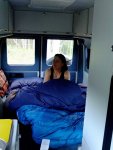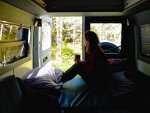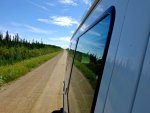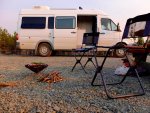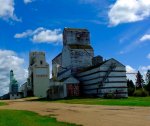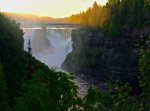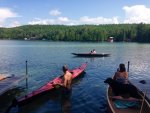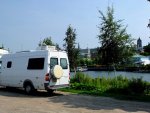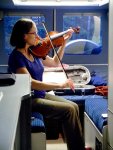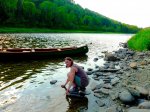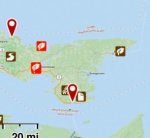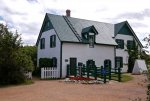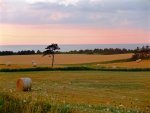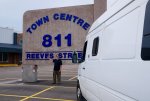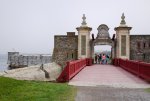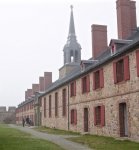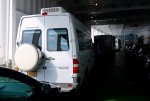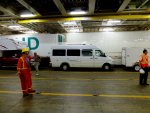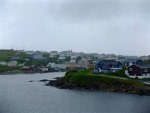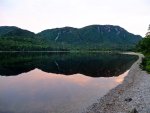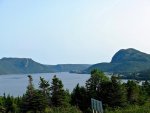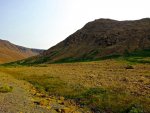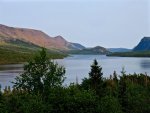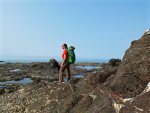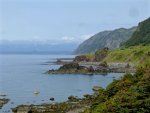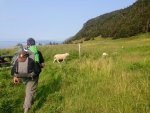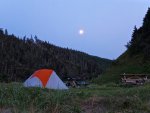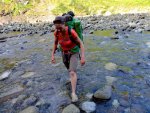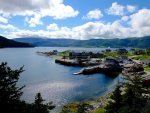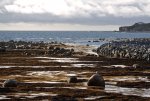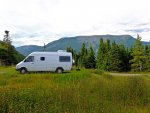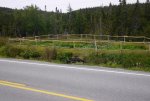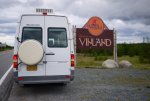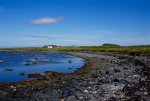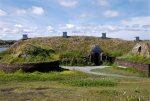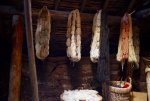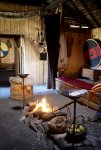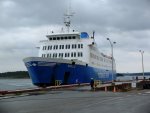Umnak
Adventurer
In August, 2014 we purchased a 2006 Sprinter from Sportsmobile Texas, where it had been on consignment from the original owners. The High Roof 158” wheel base T1N had low miles (13,500) and was in excellent condition, aside from the tires, which had spent too much time in the Colorado sun. The van stayed in Austin through the fall while Sportsmobile added 200 watts of solar panels, an inverter, Espar diesel heater, and reconfigured the long bench seats to a partial platform bed.
Two friends and I flew to Austin in early December and drove west toward Palm Springs where my wife would meet us in just under a week. Our first night was spent in one of the few state parks in Texas, just outside of Austin. From there we went across New Mexico and Arizona rough camping on BLM lands and empty campgrounds.
We are sea-kayakers and backpackers from Southeast Alaska, so the luxury of a 20 gallon water tank, toilet, counter space and cushions made this a unique experience. In winter we often book forest service cabins as a group, and by the third night the van had been given the name “the Cabin”.
There are no roads out of Juneau, and my driving had been limited to business trips through Interior Alaska for the past 17 years. Traveling 300-400 miles a day was enjoyable, especially after leaving the Interstate. We soon learned that the Sprinter also handled well on two tracks. It crawled across a couple of streams overflowing their culverts in Cochise Stronghold, Arizona, and navigated a rutted out forest service road in California that had been torn up by an early December storm.
The Sprinter's “full Cramden” driving position took a bit getting used to, but isn't a problem. The view from the huge windscreen and side windows is remarkable, and the height surpasses my 4Runner by what seems a foot. It felt nice to be on the road again.
My two friends left the van in Palm Springs where I met Eve who had flown in from Juneau. We spent a couple of nights in Joshua Tree, then headed across the state to the coast and north to Seattle. For the next 10 days we woke to views of red woods or the beach. It was a luxury to flip the heater on to cut the chill and brew tea inside the van.
While the “Cabin” spent the rest of the winter outside of Olympia, Washington, we were preparing for my retirement and Eve's transition to working as a traveling speech pathologist. We also bought a home in Port Townsend, Washington, where her parents would house sit for the next few years. I announced my retirement to my Board of Directors in late January with an effective date of May 1.
A friend and I flew to Seattle in early May, picked up the Sprinter and drove north through British Columbia and the Yukon to Skagway, Alaska where the van was driven on to the MV Aurora for the final leg by sea into Juneau. The Cassiar Highway has lost some character as it gained asphalt, but the mountains remain, as does the endless forest. The Alaska Highway is what it has always been, long distances of boredom interspaced with magical moments of wildlife and views that you just can't believe exist. The two bears who sauntered along the highway digging for voles was one such moment.
The British Columbia and Yukon campgrounds didn't open until mid May, so we found a place to camp each night by turning off a side road where the snow had melted in the increasing light.
Once back in Juneau, I wrapped up the sale of our house, started culling and packing for a 2-3 year road trip around North America.
The move to the Sprinter from our house meant a loss of about 1600 square feet of living space and another 350 from the garage. How could we have enough room to carry everything we would need, including backpacking gear and Eve's work clothing and her violin? More importantly, how would we get along in a 21' van? Neither has been a problem, perhaps because we've tried very hard over the years to keep our kayaking and backpacking base-weight low, and we don't like clutter. There is a substantial amount of cabinet space in the van. The overhead cabinets are used for clothing in the rear and store our cups, pots and pan above the sink. There is a large food storage area under the refrigerator, a counter top with a pull out pantry with an additional 8 drawers, and a storage area for our Baja Burner stove above the microwave. Duffles, back packs and hats are stowed in the voluminous cabinet above the passenger seating area forward. The bathroom cabinets hold more than we could possible fill. There is also room in there for folding chairs and Eve's fly fishing rods.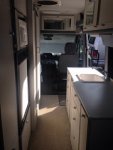
Aside from a few loud conversations stemming from navigation, we've done well spending so much time together. We've found ways to have our own space in the van. We can't see each other If I sit in the passenger seat facing the rear, and Eve sits on the port bench with her back to the closet. It's a little thing, but it helps. We had thought that a weekly stay in a hotel would offset the seemingly cramped space of the van. It turns out that hasn't been necessary. We did spend one night in a hotel on the road, and another in Labrador, but that was on an island and the Sprinter was on the mainland.
Rebuilding the bed by cutting the bench seats in half and adding a platform over the rear has given us substantially more space for storage, and having that space open to the front of the living area makes it easy to put things out of the way and off the platform at night. Transitioning to the bed is also simple, with half the bed ready for use. Our sleep system consists of two flat sheets sewn together half of the way up the side and closed at the bottom. Our double sleeping quilt is used on top as a comforter and in our tent when backpacking. A 3'x5' Turkish rug is placed under the platform mattress while on the road, and the pillows are used as bolsters.
We began living in the Sprinter at a Forest Service Campground near the Mendenhall Glacier. A leak in the Sprinter's roof appeared the night before we were leaving to meet movers in our new home in Port Townsend. I left the van with a friend who re-caulked everything on top. This proved to be only a partial fix, as a much smaller leak appears in heavy rain when the van is slanted forward. I believe it is due to the seam in the roof under the solar panels, and will have it fixed while we are stopped for a few months in North Carolina.
As of early November, 2015, we've driven 17,000 miles, and most of that in Canada. On July 29th we began this segment of the road trip by taking the ferry out of Juneau to Skagway and then into the Yukon.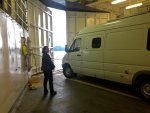
Our first night was spent boondocking at a rough camp on a micro-wave tower road a few miles from the southern bend of the Swift River. We followed the Alaska Highway for two days before turning north onto the Liard Trail toward Yellowknife. The Liard is paved for the first 10 miles then becomes gravel and dirt. Everything inside the van was covered with dust, mostly from passing trucks, though I believe that our own wheels added to the film in the rear of the Sprinter. Our only night along the Laird was spent at the Blackstone Territorial Campground, situated between the highway and its namesake river. It has the best shower (wash) room of any park we've visited. Worth the trip to see the inside, which is more like a hip urban hotel than a campground.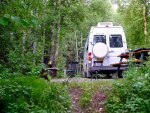
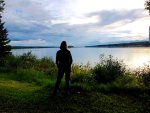
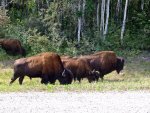
Ernie Barnhardt stopped us at a road house before the last run into Yellowknife. As a teenager in the 1930s his father left Teller Alaska on a whaler heading to the Beaufort Sea. He left the vessel at Hershel Island, which is near the Canadian border, and made his way up the MacKenzie River to Yellowknife. There he met Ernie's mother and started a family. Ernie was born there in the 1940s, the youngest of many children. We have common friends from the Nome and Kotzebue area, which he has visited during meetings of the Circumpolar Institute.
Yellowknife is a large town with a lot of banks and mobile homes. There is only one coffee shop, and it was closed on Sunday and Monday, which was a “Civic” holiday. There are no barista stands, making this the last market for Starbucks west of the Mississippi. We found the Territorial campground on the edge of the airport and settled in for a few days to explore. The historic old town is walkable and was alive with the last day of a river festival. Colorful houseboats dotted the cove and tour operators left with boats full of happy visitors. We had a wonderful meal at the eccentric Bullocks Bistro, which is housed in an historic building not far from the docks. There is an old boat in the neighbor's yard just off the back deck. The fish is from the Great Slave Lake.
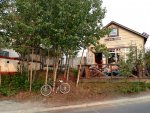
I've used the Prince of Wales Heritage Center's website to research arctic kayaks over the years and was looking forward to a prolonged visit to the exhibits. My expectations were not fulfilled. A portrait of Prince Charles — the current Prince of Wales — in full uniform and mounted on a horse is, unfortunately, one of two things that memory holds from that visit. The other is a 40 foot moose hide boat built in the 1980s. The boat was pretty cool.
The Great Slave Lake screams to be explored, and I wished for our kayaks, which were in Port Townsend hanging in the garage. The Sprinter's roof height at 9' is really too tall for us to maneuver a couple of boats, and the solar panels and AC unit provide little space even if we could reach them. It was a hard call to not bring some kind of water craft with us on this journey. We rationalized that we would rent kayaks along the way, but the only place we asked if we could rent overnight refused.
From Yellowknife we drove the eastern side of the McKenzie Highway loop into Alberta. The Louis and Alexandra falls on the Hay River are spectacular. We walked the bluff trail toward dusk, and were given the sight of a barred owl flying low toward us before veering off and up into a tree.
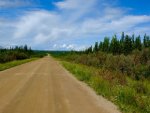
For the next five days we sped across Canada, keeping as far north as possible in Alberta, Saskatchewan and Manitoba before dropping down to the Trans Canada Highway west of Ontario. We were rushing toward the east, as even two months isn't a lot of time with the prospect of campgrounds closing along the Atlantic coast by mid-September.
During this run our days began between 6:30 and 7:00 with showers if available, then tea and breakfast. We were usually on the road by 8:30 and would drive until noon, when we would stop for lunch. Picnic areas and rest stops are plentiful along the blue highways we traveled, and parks are in many of the small towns. We turned off the highway for lunch in Manitoba and ran into a wedding party using the local picnic area for a photo shoot. The young Bride was dressed in white and looked as though she will make a strong farm wife. The bridesmaids were dressed like harlots, with long gowns split up to the thigh. Following lunch we drove, often until 6 or 7 pm and making between 300 and 400 miles a day on the two-lane roads.
Dinner are prepared using a Snow Peak Baja Burner or outside on a small Snow Peak fireplace with gathered wood or charcoal. An adapter allowing the Baja Burner to use Coleman Propane bottles proved useful in parts of Canada, where isobutane cartridges are nonexistent. A small backpacking stove is also available if we need a second pot - which we have not. Having a microwave and 3.5 cubic foot refrigerator has helped a lot too. Most of what we have for dinner is prepared using just one 3.5 quart pot. The microwave speeds things up when necessary and can act as a second burner if needed. Every couple of days we would stop at a local market for vegetables and fruit.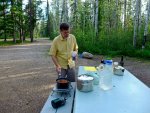
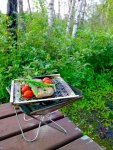
Canadian provincial and national campgrounds are abundant along this route and we would start to look for one toward the end of our day. Most were pleasant, though the Marten River Campground on the Lesser Great Slave Lake was overcrowded and filthy. Marten River only accepts on-line or phone reservations. There isn't even an “iron Ranger” in which to deposit your fee. As our phones didn't work in Canada, and we had yet found anyone who would sell us a short term account, we slipped out early the next morning to avoid embarrassing questions that might arise from a campground employee.
Boondocking wasn't as easy as I had hoped, though I imagine that would be different if we were more familiar with the area. We did camp rough on a number of occasions in Canada, at trail heads and out-of-the-way overlooks. We also stayed in a few ferry terminals in order to make early morning sailings. We've managed to avoid staying in Wal-Mart or other parking lots, more on principle than necessity.
We are settled for a few months after four months traveling. Eve has a 13 week job here Shelby, North Carolina. We decided to rent an apartment -- unfurnished -- instead of a large house fully furnished on a lake outside of the city. This allows us to walk to restaurants, galleries and music. And besides, we didn't want to take this adventure and live like we would at home. The Earl Scruggs Center in the former County Court House, and the Don Gibson Theater — which offers live music — are just a couple of blocks away. The “Cabin” is used on weekends to explore the National Forests and State Parks of western North Carolina. So now, it's back to university days with no furniture aside from what we took from the van.
I'll post another section in a day or two.
More photographs are available at http://www.flickr.com/photos/umnak/
See, Cabin on the Road, Road Trip 2014, Road Trip Canada albums
Two friends and I flew to Austin in early December and drove west toward Palm Springs where my wife would meet us in just under a week. Our first night was spent in one of the few state parks in Texas, just outside of Austin. From there we went across New Mexico and Arizona rough camping on BLM lands and empty campgrounds.
We are sea-kayakers and backpackers from Southeast Alaska, so the luxury of a 20 gallon water tank, toilet, counter space and cushions made this a unique experience. In winter we often book forest service cabins as a group, and by the third night the van had been given the name “the Cabin”.
There are no roads out of Juneau, and my driving had been limited to business trips through Interior Alaska for the past 17 years. Traveling 300-400 miles a day was enjoyable, especially after leaving the Interstate. We soon learned that the Sprinter also handled well on two tracks. It crawled across a couple of streams overflowing their culverts in Cochise Stronghold, Arizona, and navigated a rutted out forest service road in California that had been torn up by an early December storm.
The Sprinter's “full Cramden” driving position took a bit getting used to, but isn't a problem. The view from the huge windscreen and side windows is remarkable, and the height surpasses my 4Runner by what seems a foot. It felt nice to be on the road again.
My two friends left the van in Palm Springs where I met Eve who had flown in from Juneau. We spent a couple of nights in Joshua Tree, then headed across the state to the coast and north to Seattle. For the next 10 days we woke to views of red woods or the beach. It was a luxury to flip the heater on to cut the chill and brew tea inside the van.
While the “Cabin” spent the rest of the winter outside of Olympia, Washington, we were preparing for my retirement and Eve's transition to working as a traveling speech pathologist. We also bought a home in Port Townsend, Washington, where her parents would house sit for the next few years. I announced my retirement to my Board of Directors in late January with an effective date of May 1.
A friend and I flew to Seattle in early May, picked up the Sprinter and drove north through British Columbia and the Yukon to Skagway, Alaska where the van was driven on to the MV Aurora for the final leg by sea into Juneau. The Cassiar Highway has lost some character as it gained asphalt, but the mountains remain, as does the endless forest. The Alaska Highway is what it has always been, long distances of boredom interspaced with magical moments of wildlife and views that you just can't believe exist. The two bears who sauntered along the highway digging for voles was one such moment.
The British Columbia and Yukon campgrounds didn't open until mid May, so we found a place to camp each night by turning off a side road where the snow had melted in the increasing light.
Once back in Juneau, I wrapped up the sale of our house, started culling and packing for a 2-3 year road trip around North America.
The move to the Sprinter from our house meant a loss of about 1600 square feet of living space and another 350 from the garage. How could we have enough room to carry everything we would need, including backpacking gear and Eve's work clothing and her violin? More importantly, how would we get along in a 21' van? Neither has been a problem, perhaps because we've tried very hard over the years to keep our kayaking and backpacking base-weight low, and we don't like clutter. There is a substantial amount of cabinet space in the van. The overhead cabinets are used for clothing in the rear and store our cups, pots and pan above the sink. There is a large food storage area under the refrigerator, a counter top with a pull out pantry with an additional 8 drawers, and a storage area for our Baja Burner stove above the microwave. Duffles, back packs and hats are stowed in the voluminous cabinet above the passenger seating area forward. The bathroom cabinets hold more than we could possible fill. There is also room in there for folding chairs and Eve's fly fishing rods.

Aside from a few loud conversations stemming from navigation, we've done well spending so much time together. We've found ways to have our own space in the van. We can't see each other If I sit in the passenger seat facing the rear, and Eve sits on the port bench with her back to the closet. It's a little thing, but it helps. We had thought that a weekly stay in a hotel would offset the seemingly cramped space of the van. It turns out that hasn't been necessary. We did spend one night in a hotel on the road, and another in Labrador, but that was on an island and the Sprinter was on the mainland.
Rebuilding the bed by cutting the bench seats in half and adding a platform over the rear has given us substantially more space for storage, and having that space open to the front of the living area makes it easy to put things out of the way and off the platform at night. Transitioning to the bed is also simple, with half the bed ready for use. Our sleep system consists of two flat sheets sewn together half of the way up the side and closed at the bottom. Our double sleeping quilt is used on top as a comforter and in our tent when backpacking. A 3'x5' Turkish rug is placed under the platform mattress while on the road, and the pillows are used as bolsters.

We began living in the Sprinter at a Forest Service Campground near the Mendenhall Glacier. A leak in the Sprinter's roof appeared the night before we were leaving to meet movers in our new home in Port Townsend. I left the van with a friend who re-caulked everything on top. This proved to be only a partial fix, as a much smaller leak appears in heavy rain when the van is slanted forward. I believe it is due to the seam in the roof under the solar panels, and will have it fixed while we are stopped for a few months in North Carolina.
As of early November, 2015, we've driven 17,000 miles, and most of that in Canada. On July 29th we began this segment of the road trip by taking the ferry out of Juneau to Skagway and then into the Yukon.

Our first night was spent boondocking at a rough camp on a micro-wave tower road a few miles from the southern bend of the Swift River. We followed the Alaska Highway for two days before turning north onto the Liard Trail toward Yellowknife. The Liard is paved for the first 10 miles then becomes gravel and dirt. Everything inside the van was covered with dust, mostly from passing trucks, though I believe that our own wheels added to the film in the rear of the Sprinter. Our only night along the Laird was spent at the Blackstone Territorial Campground, situated between the highway and its namesake river. It has the best shower (wash) room of any park we've visited. Worth the trip to see the inside, which is more like a hip urban hotel than a campground.



Ernie Barnhardt stopped us at a road house before the last run into Yellowknife. As a teenager in the 1930s his father left Teller Alaska on a whaler heading to the Beaufort Sea. He left the vessel at Hershel Island, which is near the Canadian border, and made his way up the MacKenzie River to Yellowknife. There he met Ernie's mother and started a family. Ernie was born there in the 1940s, the youngest of many children. We have common friends from the Nome and Kotzebue area, which he has visited during meetings of the Circumpolar Institute.
Yellowknife is a large town with a lot of banks and mobile homes. There is only one coffee shop, and it was closed on Sunday and Monday, which was a “Civic” holiday. There are no barista stands, making this the last market for Starbucks west of the Mississippi. We found the Territorial campground on the edge of the airport and settled in for a few days to explore. The historic old town is walkable and was alive with the last day of a river festival. Colorful houseboats dotted the cove and tour operators left with boats full of happy visitors. We had a wonderful meal at the eccentric Bullocks Bistro, which is housed in an historic building not far from the docks. There is an old boat in the neighbor's yard just off the back deck. The fish is from the Great Slave Lake.

I've used the Prince of Wales Heritage Center's website to research arctic kayaks over the years and was looking forward to a prolonged visit to the exhibits. My expectations were not fulfilled. A portrait of Prince Charles — the current Prince of Wales — in full uniform and mounted on a horse is, unfortunately, one of two things that memory holds from that visit. The other is a 40 foot moose hide boat built in the 1980s. The boat was pretty cool.
The Great Slave Lake screams to be explored, and I wished for our kayaks, which were in Port Townsend hanging in the garage. The Sprinter's roof height at 9' is really too tall for us to maneuver a couple of boats, and the solar panels and AC unit provide little space even if we could reach them. It was a hard call to not bring some kind of water craft with us on this journey. We rationalized that we would rent kayaks along the way, but the only place we asked if we could rent overnight refused.
From Yellowknife we drove the eastern side of the McKenzie Highway loop into Alberta. The Louis and Alexandra falls on the Hay River are spectacular. We walked the bluff trail toward dusk, and were given the sight of a barred owl flying low toward us before veering off and up into a tree.

For the next five days we sped across Canada, keeping as far north as possible in Alberta, Saskatchewan and Manitoba before dropping down to the Trans Canada Highway west of Ontario. We were rushing toward the east, as even two months isn't a lot of time with the prospect of campgrounds closing along the Atlantic coast by mid-September.
During this run our days began between 6:30 and 7:00 with showers if available, then tea and breakfast. We were usually on the road by 8:30 and would drive until noon, when we would stop for lunch. Picnic areas and rest stops are plentiful along the blue highways we traveled, and parks are in many of the small towns. We turned off the highway for lunch in Manitoba and ran into a wedding party using the local picnic area for a photo shoot. The young Bride was dressed in white and looked as though she will make a strong farm wife. The bridesmaids were dressed like harlots, with long gowns split up to the thigh. Following lunch we drove, often until 6 or 7 pm and making between 300 and 400 miles a day on the two-lane roads.
Dinner are prepared using a Snow Peak Baja Burner or outside on a small Snow Peak fireplace with gathered wood or charcoal. An adapter allowing the Baja Burner to use Coleman Propane bottles proved useful in parts of Canada, where isobutane cartridges are nonexistent. A small backpacking stove is also available if we need a second pot - which we have not. Having a microwave and 3.5 cubic foot refrigerator has helped a lot too. Most of what we have for dinner is prepared using just one 3.5 quart pot. The microwave speeds things up when necessary and can act as a second burner if needed. Every couple of days we would stop at a local market for vegetables and fruit.


Canadian provincial and national campgrounds are abundant along this route and we would start to look for one toward the end of our day. Most were pleasant, though the Marten River Campground on the Lesser Great Slave Lake was overcrowded and filthy. Marten River only accepts on-line or phone reservations. There isn't even an “iron Ranger” in which to deposit your fee. As our phones didn't work in Canada, and we had yet found anyone who would sell us a short term account, we slipped out early the next morning to avoid embarrassing questions that might arise from a campground employee.
Boondocking wasn't as easy as I had hoped, though I imagine that would be different if we were more familiar with the area. We did camp rough on a number of occasions in Canada, at trail heads and out-of-the-way overlooks. We also stayed in a few ferry terminals in order to make early morning sailings. We've managed to avoid staying in Wal-Mart or other parking lots, more on principle than necessity.
We are settled for a few months after four months traveling. Eve has a 13 week job here Shelby, North Carolina. We decided to rent an apartment -- unfurnished -- instead of a large house fully furnished on a lake outside of the city. This allows us to walk to restaurants, galleries and music. And besides, we didn't want to take this adventure and live like we would at home. The Earl Scruggs Center in the former County Court House, and the Don Gibson Theater — which offers live music — are just a couple of blocks away. The “Cabin” is used on weekends to explore the National Forests and State Parks of western North Carolina. So now, it's back to university days with no furniture aside from what we took from the van.
I'll post another section in a day or two.
More photographs are available at http://www.flickr.com/photos/umnak/
See, Cabin on the Road, Road Trip 2014, Road Trip Canada albums
Last edited:

